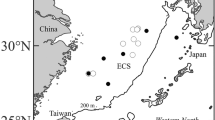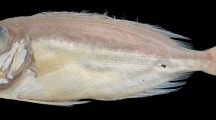Abstract
Morphological abnormalities in eye location and/or body coloration are commonly observed in hatchery-reared juveniles of many pleuronectid species, and have become one of the most serious problems in juvenile production for stock enhancement. In this study, these morphological abnormalities of six pleuronectid species—barfin flounder Verasper moseri, slime flounder Microstomus achne, stone flounder Platichthys bicoloratus, starry flounder Pl. stellatus, cresthead flounder Pseudopleuronectes schrenki, and marbled sole Ps. yokohamae—were successfully classified into four morphological types [normal, two types of pseudoalbinism (normal-eye position or top-eye position), and ambicoloration], following the same classification scheme proposed for other two pleuronectids. Based on our results, the characteristics of each morphological type are quite similar among species. It is confirmed that the normal type has the same ocular side and blind side characteristics as those of wild fish, not only in eye position and body coloration, but also in scales or dentition. The pseudoalbino types have the blind side characteristics of wild fish on both sides, with top-eye type in all characteristics, and normal-eye type in all other characteristics other than eye position. The ambicoloration type has all the ocular side characteristics of wild fish on both sides. Therefore, the pseudoalbinism and ambicoloration of hatchery-reared juveniles of pleuronectid species can be considered malformations of asymmetrical formation. Since this process normally occurs during metamorphosis, the term “metamorphosis-related malformation” is proposed for the abnormal formation of juveniles in pleuronectid species.






Similar content being viewed by others
References
Norman JR (1934) Albinism, ambicoloration and reversal. A systematic monograph of the flatfishes (HETEROSOMATA). Trustees of the British Museum, London, pp 22–29
Brewster B (1987) Eye migration and cranial development during flatfish metamorphosis: a reappraisal (Teleostei: Pleuronectiformes). J Fish Biol 31:805–833
Seikai T, Matsumoto J, Shimozaki M, Oikawa A, Akiyama T (1987) An association of melanophores appearing at metamorphosis as vehicles of asymmetric skin color formation with pigment anomalies developed under hatchery conditions in the Japanese flounder, Paralichthys olivaceus. Pig Cell Res 1:143–151
Seikai T (1992) Process of pigment cell differentiation in skin on the left and right sides of the Japanese flounder, Paralichthys olivaceus, during metamorphosis. Jpn J Ichthyol 39:85–92
Kitajima C, Hayasida G, Yasumoto S (1987) Ambicoloration and albinism in hatchery-reared frog flounder juveniles, Pleuronichthys cornutus. Bull Nagasaki Pref Inst Fish 13:17–23 (in Japanese with English abstract)
Ochiai A (1966) Studies on the comparative morphology and ecology of the Japanese soles. Bull Misaki Mar Biol Inst Kyoto Univ Spe Rep 3:1–97 (in Japanese with English abstract)
Okiyama M (1974) Studies on the early life history of a flounder, Paralichthys olivaceus (Temminck et Schlegel) II. Descriptions of juveniles and comparison with those of the related species. Bull Jpn Sea Reg Fish Res Lab 25:39–61 (in Japanese with English abstract)
Seikai T (1979) Studies on the abnormality of vertebrae and scales in company with the occurrence of anomalous in the juvenile and young of hatchery-reared flounder, Paralichtys olivaceus. Bull Nagasaki Pref Inst Fish 5:19–25 (in Japanese)
Seikai T (1980) Early development of squamation in relation to color anomalies in hatchery-reared flounder, Paralichthys olivaceus. Jpn J Ichthyol 27:249–255
Amaoka K (1964) First record of sinistrality in Poecilopsetta plinthus (Jordan and Starks), a Pleuronectid fish of Japan. Bull Misaki Mar Biol Inst Kyoto Univ 7:9–17
Kato F, Okiyama K, Tajima M (1974) External morphology and discrimination of tow species of flounder belonging to the genus Limanda (L. yokohamae, and L. herzensteini) from the Japan Sea. Bull Jpn Sea Reg Fish Res Lab 25:63–87 (in Japanese with English abstract)
Sakamoto K (1984) Interrelationships of the family Pleuronectidae (Pisces: Pleuronectiformes). Memo Fac Fish Hokkaido Univ 31:95–215
Cooper JA, Chapleau F (1998) Monophyly and intrarelationships of the family Pleuronectidae (Pleuronectiformes), with a revised classification. Fish Bull 96:686–726
Bürgin T (1986) The syncranial morphology of the bastard sole Microchirus theophila (Risso, 1810) (Pleuronectiformes, Soleidae). Neth J Zool 36:117–161
Dawson CE (1962) Notes on anomalous American Heterosomata with descriptions of five new records. Copeia 1:138–146
Dawson CE (1967) Three new records of partial albinism in American Heterosomata. Trans Am Fish Soc 96:400–404
De Veen JF (1969) Abnormal pigmentation as a possible tool in the study of the populations of the plaice (Pleuronectes platessus L.). J Cons Int Explor Mer 32:344–384
Okiyama M, Tomi W (1970) A reversed ambicolorate flathead flounder, Hippoglossoides dubius (Schmidt) from the Japan Sea. Jpn J Ichthyol 17:84–85 (in Japanese with English abstract)
Okada N, Tanaka M, Tagawa M (2003) Histological study of deformity in eye location in Japanese flounder Paralichthys olivaceus. Fish Sci 69:777–784
Okada N, Morita T, Tanaka M, Tagawa M (2005) Thyroid hormone deficiency in abnormal larvae of the Japanese flounder Paralichthys olivaceus. Fish Sci 71:107–114
Seikai T (1979) Relation between the frequency of occurrence of anomalous coloration and rearing condition in larvae of hatchery-reared flounder, Paralichtys olivaceus. Bull Nagasaki Pref Inst Fish 5:9–17 (in Japanese)
Hashimoto H, Mizuta A, Okada N, Suzuki T, Tagawa M, Tabata K, Yokoyama Y, Sakaguchi M, Tanaka M, Toyohara H (2002) Isolation and characterization of a Japanese flounder clonal line, reversed, which exhibits reversal of metamorphic left–right asymmetry. Mech Dev 111:17–24
Mutsutani K (1988) Growth and metamorphosis of the marbled sole larvae Limanda Yokohamae (Günter) in culture (in Japanese). Suisanzoushoku 36:27–32
Aritaki M, Nagakura Y (1991) Characteristics of morphological abnormalities of ocular and blind sides in hatchery-reared brown sole Pleuronectes herzensteini juveniles. Saibai Giken 19:99–107 (in Japanese)
Aritaki M, Ohta K, Hotta Y, Tagawa M, Tanaka M (2004) Temperature effects on larval development and occurrence of metamorphosis-related morphological abnormalities in hatchery-reared spotted halibut Verasper variegates juveniles. Nippon Suisan Gakkaishi 70:8–15 (in Japanese with English abstract)
Aritaki M, Seikai T (2004) Temperature effects on early development and occurrence of metamorphosis-related morphological abnormalities in hatchery-reared brown sole Pseudopleurnectes herzensteini. Aquaculture 240:517–530
Suzuki T, Washio Y, Aritaki M, Fujinami Y, Shimizu D, Uji S, Hashimoto H (2009) Metamorphic pitx2 expression in the left habenula correlated with lateralization of eye-sidedness in flounder. Dev Growth Diff 51:797–808
Okisu H, Yusa T (1979) Changes of dental number with growth in Limanda yokohamae (Günther) and discrimination of the species from L. herzensteini Jordan et Snyder. Bull Tohoku Reg Fish Res Lab 40:27–36 (in Japanese with English abstract)
Roberts RJ, Young H, Milne JA (1971) Studies of skin of plaice (Pleuronectes platessa L.). J Fish Biol 4:87–98
Seikai T (2005) Expression of anomalous pigmentation in flatfishes caused by wavered asymmetry. Nippon Suisan Gakkaishi 71:996–997 (in Japanese)
Edward DH (1971) Developmental abnormalities of the flatfish Acbirus lineatus reared in the laboratory. Fish Bull 69:537–544
Bolker JA, Hill CR (2000) Pigmentation development in hatchery-reared flatfishes. J Fish Biol 56:1029–1052
Hanada K, Fukushi G (1973) Sturdy on pigment anomaly and melanin pigment about the artificial breeding of the flatfish (Limanda yokohamae). Med J Aomori 18:6–11 (in Japanese)
Tanaka T (1997) Ecological significance of metamorphosis: biology and stock enhancement of Japanese flounder (Suisangaku Series 112). Kouseisha Kouseikaku, Tokyo, pp 52–62 (in Japanese)
Yoshizato K (1990) Cytology of metamorphosis. UP Biology Series 78. University of Tokyo Press, Tokyo, pp 1–11 (in Japanese)
Uchida K (1963) Metamorphosis of fishes. In: Kume M (ed) Vertebrata embryology. Baifusha, Tokyo, pp 115–112 (in Japanese)
Youson JF (1988) First metamorphosis. In: Hoar WS, Randall DJ (eds) Fish physiology, vol. 11B. Academic, New York, pp 135–196
Kendall AW (1984) Early life history stages of fishes and their characters. In: Moser HG, Richards WJ, Cohen DM, Fahay MP, Kendall AW, Richardson SL (eds) Ontogeny and systematics of fishes (Spec Publ no. 1). American Society of Ichthyologists and Herpetologists, Lawrence, pp 11–23
Sugiyama M, Nakano H, Yano Y, Fukuda M, Murakami N (1985) Studies on the culturing technique for flatfish larvae. I. The effect of rate of water supply into rearing tank on the abundances of albinism and reversal larvae. Bull Hokkaido Reg Fish Rea Lab 50:63–69
Saotome K, Aritaki M (1988) The abnormalities of body color and eye position in hatchery-reared brown sole Pleuronectes herzensteini juveniles. Saibai Giken 17:9–17 (in Japanese)
Acknowledgments
We are very grateful to Emeritus Prof. M. Tanaka and Prof. Y. Yamashita, Kyoto University, for their valuable advice during the course of this study. We especially acknowledge Dr. T. Kayaba (Hokkaido Institute of Mariculture) and Mr. H. Kahata (Bekkai Fishermen’s Cooperative Association Herring Hatchery) for assisting us with the collection of hatchery-reared fish. Cordial thanks are extended to Mr. S. Imamura, Mr. T. Fukunaga (Fisheries Research Agency), and Mr. T. Furusawa (National Abundantly Productive Sea Promote Association), who offered valuable suggestions about this study. We also thank Mr. J. Hirokawa, Mr. K. Hattori, Mr. K. Maruyama, and Dr. K. Ohtuki (Notojima and Miyako Station of the Japan Sea-Farming Association) for their useful suggestions and for providing us with the opportunity to conduct this research. This study was supported in part by Grants-in-Aid from the Ministry of Education, Culture, Sports and Science to M.T. and M.A.
Author information
Authors and Affiliations
Corresponding authors
Rights and permissions
About this article
Cite this article
Aritaki, M., Tagawa, M. Pseudoalbinism and ambicoloration in hatchery-reared pleuronectids as malformations of asymmetrical formation. Fish Sci 78, 327–335 (2012). https://doi.org/10.1007/s12562-011-0441-9
Received:
Accepted:
Published:
Issue Date:
DOI: https://doi.org/10.1007/s12562-011-0441-9




